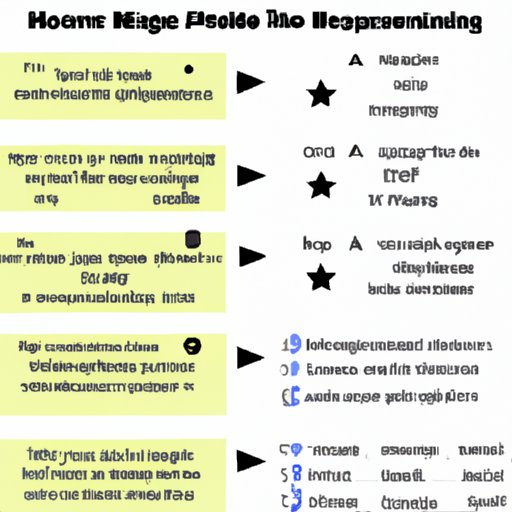Introduction
Movie ratings are an important tool for parents and guardians when it comes to choosing appropriate movies for their children. They provide an indication of the age-appropriateness of a film, as well as its content. The purpose of this article is to explore what movie ratings are in order, and provide a comprehensive guide to understanding them.

A Guide to Movie Ratings: Understanding the System
When it comes to movie ratings, there are several different levels that can be used to determine the suitability of a film for certain audiences. These ratings range from G (general audiences) to NC-17 (no one 17 and under admitted). Each rating has its own criteria, which are explained in more detail below.
Exploring the Different Levels of Movie Ratings
The Motion Picture Association of America (MPAA) is responsible for assigning the ratings to films released in the United States. The following are the common ratings assigned by the MPAA:
- G – General Audiences: All ages admitted. Nothing that would offend parents for viewing by children.
- PG – Parental Guidance Suggested: Some material may not be suitable for children. Parents urged to give “parental guidance”.
- PG-13 – Parents Strongly Cautioned: Some material may be inappropriate for children under 13. Parents are urged to be cautious.
- R – Restricted: Under 17 requires accompanying parent or adult guardian. Contains some adult material.
- NC-17 – No One 17 and Under Admitted: Clearly adult. Children are not admitted.

The Basics of Movie Ratings
In addition to the MPAA ratings, there are other organizations that assign their own movie ratings. Common Sense Media is an organization that reviews movies and assigns ratings based on content. This includes violence, language, sex, consumerism, and drinking/drugs/smoking. They also provide information about the age-appropriateness of a movie.

How to Make Sense of Movie Ratings
When looking at movie ratings, it can be difficult to make sense of them. In order to do so, it is important to understand the different types of ratings and what they mean.
Breaking Down the Different Types of Movie Ratings
The MPAA ratings are the most widely recognized and are typically used to determine the appropriateness of a film for certain audiences. However, there are other ratings systems that are used to provide additional information. Common Sense Media ratings provide insight into the content of a movie, while online movie rating systems such as Rotten Tomatoes and IMDb provide ratings based on user reviews.
What Do Movie Ratings Mean?
Movie ratings are a way for parents and guardians to make informed decisions about the type of movies their children watch. The ratings provide an indication of the age-appropriateness of a film, as well as its content. It is important to understand the different types of ratings and what they mean in order to make the best decision for your family.
Movie Ratings 101: A Comprehensive Guide
Now that you understand the basics of movie ratings, let’s take a closer look at the different types of ratings and how to make sense of them.
MPAA Rating System
The MPAA rating system is the most widely recognized and is used to determine the appropriateness of a film for certain audiences. The ratings range from G (general audiences) to NC-17 (no one 17 and under admitted). Each rating has its own criteria, which can be found on the MPAA website.
Common Sense Media Ratings
Common Sense Media is an organization that reviews movies and assigns ratings based on content. This includes violence, language, sex, consumerism, and drinking/drugs/smoking. They also provide information about the age-appropriateness of a movie.
Online Movie Rating Systems
In addition to the MPAA and Common Sense Media ratings, there are other online movie rating systems such as Rotten Tomatoes and IMDb. These ratings are based on user reviews and provide an indication of how popular a movie is with viewers.
Conclusion
Movie ratings are an important tool for parents and guardians when it comes to choosing appropriate movies for their children. By understanding the different types of ratings and what they mean, parents and guardians can make informed decisions about the type of movies their children watch. The MPAA rating system, Common Sense Media ratings, and online movie rating systems all provide useful information when it comes to making these decisions.
(Note: Is this article not meeting your expectations? Do you have knowledge or insights to share? Unlock new opportunities and expand your reach by joining our authors team. Click Registration to join us and share your expertise with our readers.)
